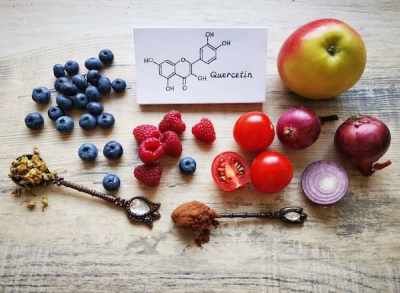Cannabis Flavonoids: Their effects and uses
Author: Lucie Garabasova
When discussing cannabis, cannabinoids are often mentioned. However, what is frequently overlooked are the synergistic compounds known as flavonoids. Together, we'll explore what flavonoids in cannabis are, their uses, and their effects.
What are flavonoids?
They are organic chemical compounds found in cannabis, green foods, fruits, and other herbs.
They protect cells from free radicals, strengthen the immune system, and help prevent heart diseases.
They are known for their rich diversity and vibrant colors in the plant kingdom. The word flavonoid comes from the Latin word "flavus," which means "bright" or "yellow," describing their most common shade.
Nearly every plant species contains about 8,000 types of flavonoids. In the cannabis plant, 20 flavonoids have been discovered to date.
Why are flavonoids so important?
Flavonoids provide nutritional value to the plant. They assist in seed development and the growth process by performing essential functions such as regulating the cell cycle.
Flavonoids also act as a defense mechanism for the plant, preventing damage from environmental stressors like bacteria, fungi, insects, and UV radiation from the sun.
In addition to regulating growth processes and providing protection, flavonoids are responsible for the appearance of plants. They contribute to the taste, aroma, and pigment differences in plants, giving each cannabis strain its unique flavor, scent, and color.
What is the role of flavonoids in cannabis?
Flavonoids, working in collaboration with cannabinoids and terpenes, interact with chemical receptors through your body's endocannabinoid system. Like these other compounds, flavonoids can have anti-inflammatory, antioxidant, and antibacterial effects, while also helping to ward off certain diseases.
Flavonoids are crucial components of the "entourage effect," which describes how the interaction of cannabinoids, terpenes, flavonoids, and other compounds complement each other when interacting with the body's endocannabinoid system. Since each strain has a different combination of these compounds, you can think of the entourage effect as the reason why different strains produce varying therapeutic effects.
What is the entourage effect?
The entourage effect = when multiple cannabinoids or compounds in cannabis work together, they create a synergy that enhances the overall effect. A prime example is full-spectrum CBD oils, which contain the complete spectrum of cannabinoids, resulting in a much stronger effect compared to CBD isolates.
The impact of flavonoids in cannabis
In practice, this means that by combining flavonoids with cannabinoids, you can maximize the effect of CBD in the human body. If you're looking for a cannabis product with a high flavonoid content, opt for cannabis tea. It uses the pure herb, and flavonoids, which are water-soluble, are released when preparing an effective cannabis tea.
Cannabis Flavonoids and their effects
The cannabis plant contains various types of flavonoids, such as cannflavin A, cannflavin B, cannflavin C, vitexin, isovitexin, apigenin, kaempferol, quercetin, luteolin, and orientin. The distribution of these compounds within the plant varies depending on the type of flavonoid, but none have been found in the plant's root system. The total flavonoid content in the leaves and flowers of cannabis can reach up to 2.5% of its dry weight, while they are almost absent in the seeds and roots.
Cannflavins A, B, and C
Cannflavins are flavonoids produced exclusively in the cannabis plant and belong to a group of flavonoids known as flavones.
They exhibit anti-inflammatory effects by inhibiting the prostaglandin inflammatory pathway. This mechanism is shared with other terpenoids present in the cannabis plant, providing better synergy and anti-inflammatory effects than cannabinoids alone.
Quercetin
Quercetin is the most abundant flavonoid in the human diet and, along with cannabis, is found in many plants, including apples, cabbage, cocoa, red onions, berries, citrus fruits, and green tea. Besides the list mentioned above, quercetin can be found in many other brightly colored, nutrient-dense vegetables. This plentiful flavonoid acts as a pigment that gives plants their color and is primarily present in the skin and leaves.
Quercetin inhibits viral enzymes and may have antiviral effects. It also inhibits the production of prostaglandins and exhibits anti-inflammatory properties. Recent studies suggest that quercetin may have therapeutic potential in the treatment of fibromyalgia due to its anti-inflammatory effects. Since cannabis has therapeutic effects in treating fibromyalgia, this could indicate a synergy between quercetin and cannabis. Similarly, quercetin inhibits the enzyme monoamine oxidase (MAO), which is involved in the metabolism of neurotransmitters and drugs. This factor needs to be considered regarding potential interactions with specific medications.
Apigenin
Apigenin is a common flavonoid found in cannabis and also in foods such as celery, parsley, tarragon, basil, oranges, onions, mint, and coriander.
It is best known for its sedative and muscle-relaxing effects by acting on GABA receptors. Apigenin constitutes 68% of all flavonoids in chamomile flowers and significantly contributes to its color and flavor. Studies have also shown that it may help combat anxiety and depression, which explains why a cup of chamomile tea can be so soothing. Apigenin is also recognized as an active antioxidant and has anti-inflammatory and antiviral effects.
Try cannabis tea with chamomile, where you can experience the maximum effect of cannabinoids and flavonoids (specifically Apigenin).
Kaempferol
Kaempferol is abundantly found in plants; in addition to cannabis, it is also present in beans, cabbage, endive, cucumbers, onions, green beans, spinach, ginger, dill, tea, and broccoli. However, the highest concentrations of kaempferol are found in capers and saffron. Kaempferol also imparts its beautiful color to rose petals. Therapeutically, it helps in the formation of new blood cells, combats inflammation, and appears to have antidepressant effects.
Luteolin and Orientin (Luteolin Glucoside)
Both luteolin and orientin have demonstrated pharmacological effects in preclinical studies, such as antioxidant, anti-inflammatory, and antibiotic properties. They may also act synergistically with cannabinoids.
Maximizing Cannabis Flavonoids
In summary, as the article shows, flavonoids are molecules responsible for the extensive range of colors and flavors in cannabis. Some flavonoids (cannaflavins) are unique to cannabis. Most of them also have anti-inflammatory and antioxidant effects.
If you consume any CBD product, it is always beneficial to add cannabis tea to achieve the maximum effects of CBD. Cannabis tea contains the highest amount of flavonoids among all cannabis products, and these flavonoids are water-soluble.




